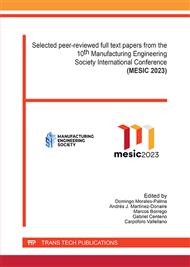[1]
Durán Becerra, T. La creación en tiempos de guerra y la explosión de la creatividad, RUTA: Revista Universitària de Treballs Acadèmics, nº5, Barcelona, 2013.
Google Scholar
[2]
Bruhn de Hoffmeyer. Las armas en la historia de la reconquista. Gladius, 31-101. ISSN: 0435-029X, Buenos Aires, 1988.
DOI: 10.3989/gladius.1988.108
Google Scholar
[3]
González Mínguez, C. La Urbanización del litoral del norte de España (siglos XII-XIV). Nájera, pp.43-62. 1993.
Google Scholar
[4]
D. Cotts, J. Europe's Long Twelfth Century: Order, Anxety and Adaptation, 1095-1229 (European History in Perspective). England, Palgrave Macmillan, 2013.
Google Scholar
[5]
Soto Rodríguez, J.A. El arte medieval: Una mirada desde el siglo XI. Revista Tiempo y Espacio, nº 26: pp.67-93, 2011.
Google Scholar
[6]
Ruiz Moreno, M. J. y Rebollo García, F. (2008). El trabuco de Cortés. XXXVI Coloquios Históricos de Extremadura. Vol. 2: 719-734.
Google Scholar
[7]
Sierra C., C. E.. Tecnología Bélica Medieval. Giro en la historia de la tecnología. Revista Universidad de Antioquia, nº 315: pp.52-60, 2014.
Google Scholar
[8]
Ruiz Moreno, M.J., Rebollo García, F. El trabuco de Cortés. XXXVI Coloquios Históricos de Extremadura. Vol. 2: pp.719-734. 2008.
Google Scholar
[9]
Aranegui Gascó, C. Proyectiles de honda con epígrafes griegos atribuidos a Sagunto. Romula, nº 2: pp.43-52. (2003)
Google Scholar
[10]
Ministerio de Defensa, Dirección General de Relaciones Institucionales. Aproximación a la historia militar de España. Volumen 1 y 3. ISBN: 84-9781-244-1. 2006.
Google Scholar
[11]
Dreger de Araujo, V. C. A arte da guerra no século XII: As campanhas italianas de Federico I Barbarossa (1154-1162). São Paulo, Universidad de São Paulo, Faculdade de Filosofia, Letras e Ciências Humanas. Departamento de Historia. 2004.
DOI: 10.11606/9788575064351
Google Scholar
[12]
E. Chevedden, P., Eigenbrod, L., Foley, V., Soedel, W. The Trebuchet, Scientific American, pp.66-71. 1995.
DOI: 10.1038/scientificamerican0795-66
Google Scholar
[13]
Suñé Arce, J. Técnicas de ataque y defensa en los asedios del siglo XIII: Ámbito catalano-aragonés y occitano. Gladius, pp.113-130, 2013.
DOI: 10.3989/gladius.2013.0005
Google Scholar
[14]
Vieira Júnior, N., Sander Bernardes C., Alves, A., Henrique B., Gomes Pereira, B., Olímpio P. da Silva, G., de Souza, M. L., Vieira de Castro, P. I., Lúcio da Silva, W. Trebuchet construido com palitos de picolé. Instituto Federal de Minas Gerais, Bacharelado em Engenharia Mecânica, 2016.
DOI: 10.20906/cps/con-2016-0558
Google Scholar
[15]
Coetzee, D. y W. Eysturlid, L. Philosophers of War: The Evolution of History's Greatest Military Thinkers. Santa Barbara, 1: 1-191. 2013.
Google Scholar
[16]
Soto Rodríguez, J.A. El arte medieval: Una mirada desde el siglo XI. Revista Tiempo y Espacio, nº 26: pp.67-93. 2011.
Google Scholar



